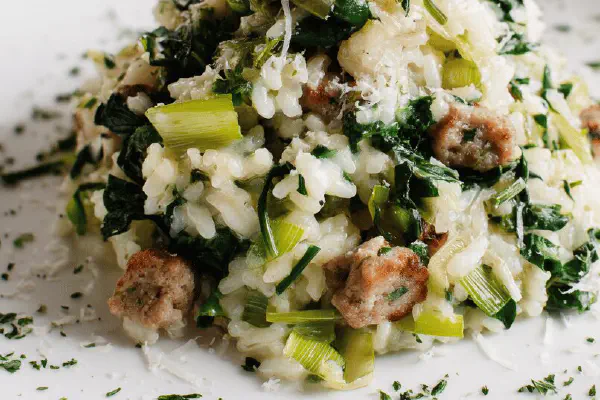Lemon Saffron Risotto

By Emma
Certified Culinary Professional
Ingredients
- 2 tablespoons olive oil
- 1 bulb fennel, sliced thin
- 1 bunch asparagus, trimmed and cut into 2-inch pieces
- coarse sea salt
- freshly ground black pepper
- 4 cups vegetable broth (or chicken broth)
- 2 tablespoons unsalted butter
- 1 medium yellow onion, finely chopped
- 3 garlic cloves, minced
- 1 1/2 cups Arborio rice
- a pinch of soaked saffron threads (about 1/4 teaspoon), soaked in 2 tablespoons warm water
- 3/4 cup dry white wine
- zest of 1 lemon
- 1/4 cup toasted pine nuts
- juice of 1 lemon
About the ingredients
Method
- Oven to 410°F. Toss olive oil, fennel slices, and asparagus chunks in a medium bowl with salt and pepper. Make sure veggies are slicked and shiny but not drowning. Transfer to a rimmed baking sheet, leave any extra oil behind in bowl.
- Roast in oven, eyes on veggies. 11 to 15 minutes – tender with edges browning and crisping. Fennel smells sweet, asparagus slightly charred. Pull out, set aside but keep warm.
- Broth in small pot. Keep barely bubbling on low heat – want almost simmer but not boiling. This insures steady warm addition.
- Butter into big skillet, melt gently over medium-low heat. Dump onion in. Stir soft 3-5 minutes. Look for translucency, not browning; aroma should tease garlic and sweetness.
- Add garlic. Cook 1-3 minutes more until fragrant but no burning. Stir often, garlic turns golden but not dark brown.
- Pour arborio rice in. Stir constantly so each grain is coated in butter. Toast until faint nutty aroma, grains edges start to look translucent, about 3-5 minutes. Little pops and crackles under heat mean ready.
- Saffron threads plus soaking water added here. Also wine. Stir till alcohol scent fades and rice swells slightly, around 4-6 minutes. Rice will absorb wine slowly, not dry out.
- Add warm broth, ladle by ladle. Stir non-stop, scraping pan bottom to prevent sticking. Wait until liquid mostly absorbed before next ladle. Rice kernels swell, creamy texture develops. Around 20-25 minutes total broth addition.
- Near finish, stir in lemon zest, salt to taste, the roasted fennel and asparagus, and toasted pine nuts. Mixed gently but fully incorporated.
- Right before you plate it, squeeze fresh lemon juice over risotto. Brightens flavors and adds acidity balance. Give one last stir.
- Taste and adjust salt and pepper. Serve immediately. Risotto should be creamy, grains tender with slight bite, vegetables softened but not mush.
Cooking tips
Chef's notes
- 💡 Roasting veggies at 410 F or slightly higher. Critical for crisp edges. Toss well but avoid drowning in oil. Too little oil dries them, too much soggy. Watch closely 11-15 minutes. Break edges darken, aroma shifts, that’s your cue to pull out. Hot oven helps caramelize sugars fast - fennel smells sweet, asparagus chars lightly.
- 💡 Broth must stay barely simmering, not boiling or cold, or rice cooking rhythm breaks down. Keep broth warm in small pot nearby. Add ladle by ladle only after liquid mostly absorbed. Keeps rice creamy, prevents mushy or clumpy texture. Constant stirring scrapes pan bottom, keeps grains separate but tender. Test bite often, better than timed guesswork.
- 💡 Butter first, melt slow on medium-low. Onion added then garlic after 3-5 mins onion softens translucent but no brown. Garlic cooks fast, turns golden but avoid dark. Rice tossed then toasted 3-5 mins with butter gives nutty aroma and translucent edges. Pops crackles mean ready. Don’t rush, overheated tastes smoky, under toasted bland.
- 💡 Saffron soaked in warm water releases color gradually. Added with wine. Stir until alcohol scent fades, rice swells slightly 4-6 mins. Wine softens acid bite, adds complexity. Can substitute half vinegar diluted if dry wine unavailable. Watch liquid absorption, slow and steady keeps starches releasing, creamy texture builds.
- 💡 Pine nuts toasted till light brown - watch closely, burn fast. Adds crunch contrast. Lemon zest stirred near finish, delicate oils brighten without bitterness. Juice added last, fresh and just before plating. Avoid juice sitting too long on risotto or flavor dulls, acid cuts through richness sharply. Adjust salt carefully at end, risotto tolerates corrections well.
Common questions
Can I use chicken stock instead of vegetable broth?
Yes, chicken stock works. Adds richer background flavor, not a problem. Watch salt levels, chicken broth can be salty. Vegetable broth lighter but swap easy. Both need warming to near simmer, cold broth stalls rice cooking quick.
What if I don’t have Arborio rice?
Carnaroli is a solid swap. Similar starch content, creamy result too. Avoid long grain rice, won’t get creamy. Other short grains not optimal but okay with less creaminess. Texture will differ noticeably if you stray from Arborio or Carnaroli.
My risotto turns mushy, what went wrong?
Usually overcooked or too much broth added too fast. Stirring erratic breaks grains, lose structure. Keeping broth warm and adding ladles slowly fixes this. Also toast rice well – under-toasted rice doesn’t hold bite. Timing based on bite test, texture, no stopwatch.
How to store leftovers?
Store in airtight container, fridge up to 2 days. Reheat gently with splash broth or water, stir to loosen. Risotto thickens when cold; add liquid to loosen on reheat. Can freeze but texture changes, grain softens more. Best served fresh but reheats nicely with care.



